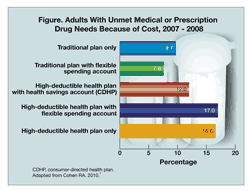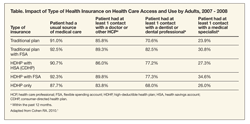- Clinical Technology
- Adult Immunization
- Hepatology
- Pediatric Immunization
- Screening
- Psychiatry
- Allergy
- Women's Health
- Cardiology
- Pediatrics
- Dermatology
- Endocrinology
- Pain Management
- Gastroenterology
- Infectious Disease
- Obesity Medicine
- Rheumatology
- Nephrology
- Neurology
- Pulmonology
Patients With HDHPs Have Unmet Medical and Prescription Needs
Adults aged 18 to 64 years enrolled in high-deductible health plans (HDHPs) with or without a flexible spending account (FSA) may be less likely to have their medical and prescription drug needs met because of cost than those adults with traditional health plans and consumer-directed health plans (CDHPs)
Adults aged 18 to 64 years enrolled in high-deductible health plans (HDHPs) with or without a flexible spending account (FSA) may be less likely to have their medical and prescription drug needs met because of cost than those adults with traditional health plans and consumer-directed health plans (CDHPs) (Figure).1

Robin Cohen, PhD, statistician at the National Center for Health Statistics, led a study that examined data from the 2007 and 2008 National Health Interview Survey. Of the persons who were interviewed, 92,450 were included in the family sample and 36,147 were included in the adult sample.
Among the adults enrolled in an HDHP from 2007 to 2008, 2% had an FSA, 12% had no FSA, and 5% had a CDHP. Enrollment in an FSA or health savings account was associated with increased health care access and use (Table). Specifically, use of influenza vaccination as well as contact with an eye doctor or dental professional was shown to increase.

Enrollment in HDHPs and CDHPs is rising, and the use of FSAs continues to increase, according to Cohen. From 2007 to the early half of 2009, enrollment in HDHPs and CDHPs jumped from 17.5% to 22.7%. In this same period, the number of persons within a family with an FSA rose from 16.7% to 20.2%2
References:
References
1. Cohen RA. Impact of type of insurance plan on access and utilization of health care services for adults aged 18-64 years with private health insurance: United States, 2007-2008. http://www.cdc.gov/nchs/data/databriefs/db28.htm. Published February 2010. Accessed February 25, 2010.
2. Martinez ME, Cohen RA. Health insurance coverage: early release of estimates from the national health interview survey, January-June 2009. http:// www.cdc.gov/nchs/data/nhis/earlyrelease/insur200912.pdf. Published December 2009. Accessed February 25, 2010.
